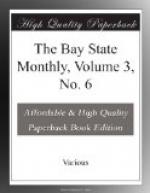The remedy for the wrongs and faults of the system is, in his opinion, to recognize the individuality of children in the schoolroom to study the mental peculiarities and needs of each, and to do away with the system so far as it interferes with the liberty of the teacher to adapt his means to the proper ends to be attained. It is demanded that teachers be selected on the sole ground of fitness and adaptability, and not because of favoritism or the mere fact that their book education is sufficient, and it is further insisted that parents interest themselves to see and demand that the best that can be done is done for their children. These are the means suggested in the way of reform, and they seem adequate in a large degree to accomplish what is desired. We commend the book to teachers and parents.
MONEY IN POLITICS. By J.K. Upton. With an introduction by Edward Atkinson. Boston: D. Lothrop & Co. Price $1.00. The author of this comprehensive and valuable work was for several years Assistant Secretary of the United States Treasury, and in that responsible position had admirable facilities for studying the question of money as affected by congressional acts from the earliest history of the republic down to the present, and he has made good use of his opportunities in this book which is a succinct narration of the numerous changes made in American money beginning with the continental issues, in fact, earlier, the colonial money. The work is, therefore, a history of American coin and the numerous issues of paper that served as money. To the student there is in this book a fund of information extremely interesting, particularly at this time when the popular will is likely to compel farther legislation. A topic of present interest, is the silver dollar, to which the author devotes a chapter historical in its character, and another chapter concerning circulation of this coin. In the former chapter he begins with the Spanish milled dollar, “the Mexican pillar piece,” which was the first silver dollar known in American commerce, and had, in colonial times, 386.7-8 grains of pure silver. In 1785 the American standard was fixed at 375.64 grains of pure silver which became the unit of account, the standard dollar. In 1792, after a Congress of the States was organized, the standard dollar was required to contain 371.25 grains of pure silver, or, with the admixture of baser metal, the standard of silver coin 416 grains, the pure silver rated by itself as before. These facts are of interest as showing the origin of the American dollar recognized as the standard down to 1873.




